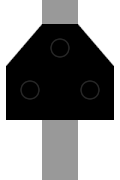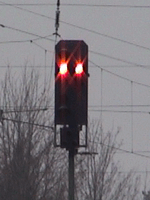Replacement signal on the opposite track
The opposing track replacement signal ( Zs 8) is a railway signal from the group of additional signals and is located at main signals .
It has a similar meaning to the substitute signal . All regulations apply as for the substitute signal, but the signal also indicates that the route leads into the main track in the opposite direction. This signal aspect is not required if a form signal Zs 6 (opposite track indicator) is attached at the location of the main signal. Then the substitute signal can be shown, which contains the instruction to drive on the opposite track as a form signal through the counter-track indicator. Where the signal Zs 8 is used, a main signal or a low-level light blocking signal is available in the following operating point on the opposite track . The travel order given by the signal Zs 8 ends there.
According to the signal book (guideline 301 of the Deutsche Bahn AG), it orders : “ Drive past the main signal that shows a stop or that is disturbed, the route leads into the main track against the normal direction of travel. "
The operational actions for a train journey with a special order must be observed.
As with the substitute signal, there are two variants for the signal aspect:
- " Three flashing white lights in the form of an A ": In the area of the former German Federal Railroad (DS 301), the lanterns of the replacement signal are also used. In contrast to the substitute signal shown by the parking light, the signal image flashes.
- " A white flashing light strip rising from right to left ": In the area of the former Deutsche Reichsbahn (DV 301) and the Ks signal system, the signal image, which is similar to the Zs 6 signal, but flashes. The same additional indicator is used for signals equipped with both signal aspects.
If, for example, a line track is closed for construction work on a double-track line, the procedure is as if the remaining track is a single-track line. However, if this is not equipped with safety equipment for travel in both directions, a main signal cannot be used in the opposite direction. For this reason, train detection operation is introduced on this track as on a single-track line and because the track block does not exist in the opposite track direction, additional feedback is introduced and the journey can then take place on the opposite track replacement signal.
The order to use the track in the opposite direction is valid until the next train station. If there is a branch or transfer point in front of the train station, the order is only valid until then. Entrance to the next train station takes place via an entry signal on the track being used or a blocking signal set up at the level of the entry signal of the other track (the latter is low and only in the area of the ex-DB). The signal patterns Hp 0 / Zs 1 and Hp 0 / Sh 1. If there is a complete route for this left-hand entrance and the signal is appropriately equipped, then regular travel terms can be used.
The opposite-track substitute signal is also used if, when the track-changing mode is set up, the opposite track is to be driven out and the exit signal does not come into the driving position due to a fault.
Like the substitute signal Zs 1 and the caution signal Zs 7, the opposite-track substitute signal also applies if it goes out before the head of the train has passed the signal.
In the course of development, the opposite track substitute signal had different names. It was introduced with the signaled wrong-way operation as a wrong-way order signal , the Deutsche Reichsbahn changed the name in the course of the systematisation of the procedures for driving on the left track in the 1980s to left-hand drive substitute signal .
Web links
Individual evidence
- ↑ Guideline (Ril) 301 of the Deutsche Bahn, module 301.0301, section 9, paragraph 1 as well as in the ESO
- ↑ Ril 301, Module 301.0301, Section 9, Paragraph 2 as well as in the ESO
- ↑ Youtube: Replacement signal on the opposite track with three white flashing lights in the form of an A (ex-DB version). Retrieved June 4, 2014 .
- ↑ Youtube: Replacement signal on the opposite track with white flashing light strips (ex-DR and Ks signals). Retrieved June 4, 2014 .





